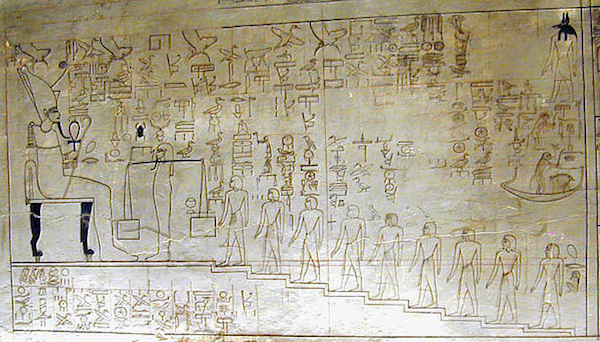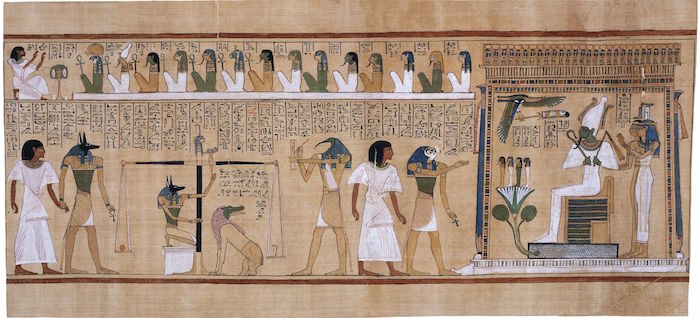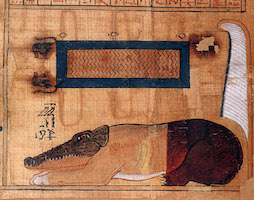Ancient Egyptian texts refer to two distinct forms that the Judgement of the Dead can take. The first sees judgement as a continuous process, with the dead being subject to the decisions of a court in much the same way as they were when they were alive. The second sees death as the moment when the whole life of a person is judged, with a verdict which has far reaching consequences for their afterlife. Those found to be pure are declared to be an Akh (transfigured spirit) who is Maat-heru (true of voice), while those found wanting face the feared second death. They might be fed to the terrifying demon Ammit, or thrown in the Lake of Fire.
The first form of continuous assessment is apparent in the inscriptions found in Old Kingdom tombs which threaten those guilty of tomb robbery or vandalism with serious long term consequences, and in parts of the Coffin Texts (Middle Kingdom). We can also hear echoes of this form of judgement in the Letters to the Dead (Old Kingdom and First Intermediate Period) in which the living wrote to their recently deceased relatives to ask for their help with a problem.

The second form, in which the soul of the deceased is judged worthy or not worthy, first appears in the Coffin Texts of the Middle Kingdom. The deceased must enter the Hall of Judgement and face Osiris and numerous other deities. Their heart (or occasionally another body part) was weighed to determine whether they were worthy to enter the afterlife as one of the blessed dead.
The wisdom texts of this period also make reference to the judgement of the dead, and the idea that only the worthy will get an enjoyable afterlife. For example, the didactic text The Instructions of Merikare observes…
Man survives after death, and his deeds are laid before him in a heap… as for the man who reaches them without doing evil, he will abide there like a god, roaming (free) like the lords of time.
This concept was further developed in the New Kingdom. In the Book of Gates the judgement of the dead occurred immediately before the union of the Ba of the sun god with his body, at the deepest part of the night. Osiris sits in the Hall of Judgement, the scales of justice before him, and waits to assess the deceased. Those who fail this test will be destroyed. Hovering over Osiris there are four inverted gazelle heads, labelled “The Roarers”. A mummiform deity representing a member of the Ennead stands on each of the nine steps leading up to the throne of Osiris. Above them (beside the scale) there is a monkey wielding a curved stick to drive off a pig in an apparent attempt to drive of evil through the power of mockery.
The most fully developed description of the Hall of Judgement is found in the Book of the Dead, in particular in Spell 125. This complex, and lengthy, text contains the Negative Confession in which the deceased asserts (first to Osiris and then to forty-two other judges) that they are worthy by listing the crimes and offences they have not committed. Then the heart of the deceased was weighed against the feather of Ma’at. Spell 30 of the Book of the Dead is testament to the pragmatism of the Egyptians. It ensures that the heart would not speak out against them when they were being judged! They could also appeal to Thoth for his help in gaining a positive outcome in the Hall of Judgement (Spell 20 of the Book of the Dead).

Spells 125 and 30 were the most commonly included spells out of the whole corpus of the Book of the Dead. Spell 30 first appeared during the late Middle Kingdom or early Second Intermediate Period on a series of heart shaped scarabs, while Spell 125 is not known before the reign of Hatshepsut. After the New Kingdom, the vignette associated with Spell 125 also appears with other spells from the Book of the Dead and on coffins, shabti chests, mummy wrappings and shrouds. There is one example, in Der el Medina, of it appearing as a relief in a Ptolemaic temple. Spell 125 remained popular in Egyptian burials until the Roman Period. During this time, the vignettes associated with Spell 125 were still employed, but the majority of the accompanying text was taken from the Book of Breathings with only excerpts from Spell 125 being included.
Even though Spell 30 hoped to prevent the heart from speaking out against the deceased in the Hall of Judgement, Quirke has argued that the inclusion of these texts was not expected to exempt a person from judgement. Those who were not able to include these texts in their burial due to lack of funds were not seen to be at a disadvantage, and a rich person could not just buy their way into paradise. The first time that it is suggested that there might be a distinction between a poor but blessed person and a rich but damned person is in the Demotic Tale of Setna and his Son in which the influence of Hellenistic philosophy may be implied.
The weighing scene was sometimes paired with a depiction of the Lake of Fire, which destroyed the unworthy but nourished the good. The lake was depicted as a rectangular stretch of water with a baboon at each corner and a flaming red torch on each side. This vignette was linked to Spell 126, in which an appeal for assistance was made to the Baboons (representing Thoth). The baboons are described as the ones who judge poor and rich, and the deceased begs them to…

Expel my evil, grip hold of my falsehood that I may have no guilt in respect of you.
This text implies a further level of judgement. However, in this instance, it would seem that the spell does indeed allow the deceased to avoid judgement as the baboons reply;
Come so that we may expel your evil and grip hold of your falsehood so that the dread of you may be on earth, and dispel the evil which was on you on earth.
Clearly, Egyptians from the Middle Kingdom onward believed that when they died there would be an accounting for the deeds they had committed during their lives. However, they could look to some of the gods for assistance, and employ spells to both guide and protect them.
Bibliography
- Grajetzki, W (2003) Burial Customs in Ancient Egypt
- Hornung, Erik (1999) The Ancient Egyptian Books of the Afterlife
- Ikram, Salima (1997) Death and Burial in Ancient Egypt
- Faulkner, Raymond O (1972) The Ancient Egyptian Book of the Dead
- Redford Donald B (2002) Ancient Gods Speak
- Stadler, Martin A (2008) Judgment after Death (Negative Confession) From Encyclopedia of Egyptology Edited by Jacco Dieleman and Willeke Wendrich
- Teeter, Emily (2011) Religion and Ritual in Ancient Egypt
Copyright J Hill 2018